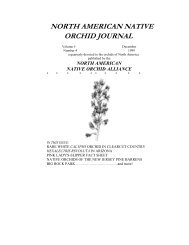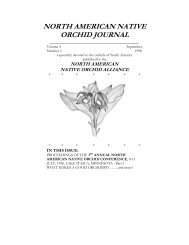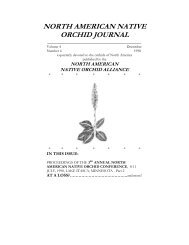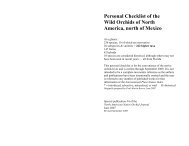north american native orchid journal - at The Culture Sheet
north american native orchid journal - at The Culture Sheet
north american native orchid journal - at The Culture Sheet
Create successful ePaper yourself
Turn your PDF publications into a flip-book with our unique Google optimized e-Paper software.
Brown & Folsom: WILD ORCHIDS OF THE WHITE MOUNTAINS OF NEW HAMPSHIRE AND MAINE<br />
Pl<strong>at</strong>anthera huronensis (Nuttall) Lindley<br />
green bog orchis<br />
Range: Alaska east to Newfoundland, south to California and<br />
Pennsylvania<br />
In the White Mountains region: sc<strong>at</strong>tered to occasional throughout;<br />
more frequent <strong>north</strong>ward<br />
Plant: terrestrial, 10-100+ cm tall<br />
Leaves: 2-4; cauline, linear-lanceol<strong>at</strong>e, gradually reduced to bracts; 1-6<br />
cm wide × 5-30 cm long<br />
Flowers: (8)20-75+; arranged in a loose to dense terminal spike;<br />
dorsal sepal obov<strong>at</strong>e, arching; l<strong>at</strong>eral sepals linear-oblong, spreading to<br />
recurved, petals ov<strong>at</strong>e to lance-falc<strong>at</strong>e, somewh<strong>at</strong> enclosed within the<br />
dorsal sepal forming a hood; lip lanceol<strong>at</strong>e, descending, or the apex<br />
caught within the tip of the dorsal sepal and petals; sepals whitishgreen,<br />
petals and lip pale greenish-white but markedly whiter than<br />
the sepals; individual flower size 0.8 x 1.3 cm, not including the<br />
0.4-1.2 cm somewh<strong>at</strong> cylindric spur; flowers are<br />
autogamous, with the downward-pointing pollinia<br />
remaining in the anther sacs.<br />
Habit<strong>at</strong>: open wet meadows, roadside ditches and seeps,<br />
fens, bogs, and river gravels<br />
Flowering period: l<strong>at</strong>e June to August<br />
Pl<strong>at</strong>anthera huronensis is the most widespread and frequently<br />
encountered of all of the green-flowered rein orchises in <strong>north</strong>eastern North America. <strong>The</strong><br />
tall spikes are frequently found in a wide variety of habit<strong>at</strong>s and like many species of<br />
Pl<strong>at</strong>anthera, their habit varies with the habit<strong>at</strong>. Plants of open wet areas have densely flowered<br />
tall spikes with<br />
many flowers<br />
whereas those of<br />
woodlands often<br />
have few-flowered,<br />
slender spikes. <strong>The</strong><br />
flowers are usually<br />
intensely fragrant.<br />
Sheviak (2002)<br />
st<strong>at</strong>es th<strong>at</strong> although<br />
hybrids with P.<br />
dil<strong>at</strong><strong>at</strong>a may occur<br />
the name traditionally<br />
used for them,<br />
P. ×media, is<br />
actually a synonym<br />
for P. huronensis.<br />
241













